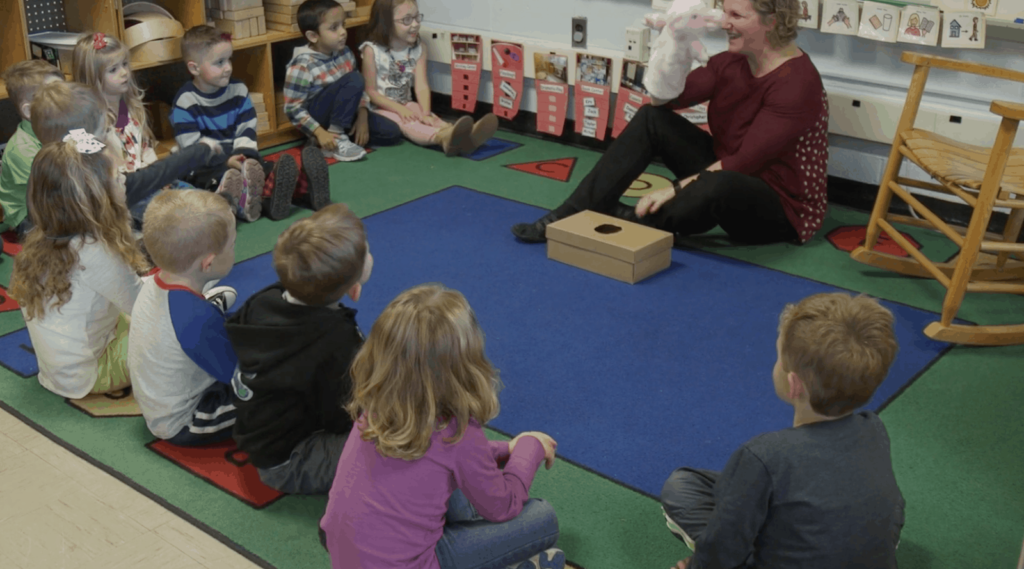Using Engineering Activities to Support SEL in Early Childhood Education

By: Nia Keith
With the growing focus on social and emotional learning (SEL) in education, you likely have come across dozens of different ideas and methods for incorporating it into your classroom. One you might not have encountered, however, is to teach engineering to our youngest learners.
There’s a natural connection between engineering and SEL core competencies, and engineering provides unique opportunities for educators to support and nurture SEL, especially when it’s taught in early childhood. For example, when preschoolers and kindergarteners engineer, they learn how to empathize with others, make responsible decisions, regulate their emotions, share materials and collaborate.
Based on our work developing preschool and Kindergarten engineering curriculum, below are four essential components for creating engineering challenges that support and grow SEL in young children.
1) Set the engineering challenge in a real-world context
At the heart of engineering is problem-solving, and at the heart of problem-solving is empathy. An engineer uses creativity and the knowledge of science and math to design technologies that improve the lives of people, animals, society and/or the environment.
High-quality engineering design challenges start by setting the engineering problem that children will solve within a real-world context. This context helps children identify what the problem is, why it is important, how it applies to their lives and then challenges them to apply knowledge to solve the problem. This builds their social awareness, empathy and respect for others.
Preschoolers, especially, respond to immediate and familiar problems, and roleplay is a highly-motivating technique for kids between ages three and four. Wee Engineer, our preschool curriculum, has teachers use puppets and roleplay to provide a clear, captivating context for the engineering work they will assign their classes. We give them a script and appropriate prompts that center around ideas that will help kids focus on the “why” of what they’re creating and how it connects to the real world. This roleplay and use of the puppet motivates children to persevere and reach their goals as they explore, create and improve.
When we ask young learners to engineer, we develop their ability to empathize with others and guide them to see the benefit in helping others as they work to solve a problem for someone else.
2) Use engineering to develop responsible decision making
An engineering design challenge helps young children learn how to identify and solve problems.
In early childhood, children are still developing the skill of making informed, responsible decisions. From our research and during our curriculum development, we found that giving students the options to choose what materials to use—one of the most important aspects of an engineering design challenge at this age—provided the most powerful learning opportunity for young kids. For example, during early pilot rounds of the Wee Engineer activity Rafts, which challenges students to build a raft out of common household items, we learned very quickly that sometimes children’s knowledge of the properties of materials doesn’t override their drive to use the coolest looking materials. One class, in particular, was engineering a raft (a CD) to float a toy above water. To make the raft float, they would choose materials to attach to the bottom of the CD using Velcro.
This is what we heard from a preschool from one of our pilot classrooms:
The preschoolers all grab for the neon smiley-face erasers. One boy sticks four erasers onto his CD, puts it in the water, and it sinks. He smiles. Another girl does the same. They both say, “Mine made it float!” Their teacher comes over and reminds the kids that float means to stay on top of the water. “What should we use to make the raft float?”
A boy, who hasn’t made anything yet, attaches four smiley-face erasers. Just like his peers. The raft sinks again. But unlike his peers, this young boy is willing to try another material. He puts the corks on his CD. It floats!
Eventually, every child solves the problem of how to make their raft float, but not without first trying out the smiley face eraser. This taught us the importance of prompting and frequent reminders about the problem they’re trying to solve are essential when instructing a young class through a challenge—but also that the role of the educator to support and facilitate responsible decision making is critical, too.
Children’s choices about materials are often swayed by their peers. To counteract this effect, we recommend using an “Idea Box”, which is a very simple strategy that helps broaden preschoolers’ social awareness and encourages them to think differently about how they identify, analyze and solve problems.
During an engineering challenge, educators can use the Idea Box to record what materials are effective. For example, Wee Engineer’s Noisemaker activity challenges children to make a loud noisemaker for a beloved puppet. After children explore materials and identify one or two materials that they think the puppet should use to make a loud noisemaker, they slip the material into the Idea Box. Later in the activity, the teacher empties the Idea Box, and as a group, the class learns what materials each member individually thought was best. Kids may not remember what material they put in the idea box—and that’s okay. It’s more important that they realize that, as a group, they came up with many different ways to solve the problem. This entire process helps reinforce their evaluation and ultimately their informed decision-making techniques.
3) Use engineering to support collaboration
Engineering is all about teamwork and collaboration, a critical skill set in SEL. Very young children actively develop their awareness of the world around them. They’re still learning how to share and compromise with each other. Collaboration looks very different for children who are three and four. It’s important to structure activities in ways that build the appropriate foundation for collaboration. For example, during the pilot testing of EiE for Kindergarten, we learned that kindergarteners work best in pairs. When kids worked in larger groups, often one child was left out of the process. Kindergarteners communicate more easily in pairs and it’s easier for kids to share responsibilities and materials. And when it came to agreeing upon a plan for their technology, a consensus was easier in pairs.
4) Use engineering to develop a growth mindset and persevere through failure
The improve step is an important part of any engineering task, as it’s a crucial step in the engineering design process (EDP). The EDP is an iterative problem-solving tool that engineers use to create technologies.
The engineering design process channels children’s energy and curiosity into structured problem-solving. During an engineering design challenge, the focus is less on the final product and more about the function of the object and the steps one takes to get there. As young engineers follow the steps of an age-appropriate engineering design process, they learn how to persevere through failure and develop a growth mindset. For many preschoolers and kindergarteners, when they engineer, it’s the first time they’re being asked to think about how they can make something they’ve created even better. This focus on the improve step creates a safe space for children to fail, builds their self-confidence and helps them recognize strengths they didn’t know they had.

It’s never too early for young children to start engineering. Children are natural problem solvers. Here’s a recap of the four key ways to structure engineering challenges for our youngest learners to maximize SEL growth:
- Set a strong context for the problem that the students will solve. This builds empathy.
- Develop opportunities for strong decision making. This builds responsible decision makers and an understanding of how decisions impact outcomes.
- Support collaboration. This builds the foundation for working together, sharing, and compromise.
- Build a growth mindset and persevere through failure. The iterative nature of engineering supports the development of a growth mindset.
Thoughtfully structured engineering activities can set young learners up for success in school and life. Plus, kids have a ton of fun!
Nia Keith is the director of professional development for EiE (@EiE_org) at the Museum of Science, Boston.
For more, see:
- Preparing Students For Future Success with PBL and SEL
- 50 Organizations, Schools, Networks and Resources Improving SEL
- Practical Ways to Bring SEL into the Classroom
Stay in-the-know with all things EdTech and innovations in learning by signing up to receive the weekly Smart Update.






0 Comments
Leave a Comment
Your email address will not be published. All fields are required.